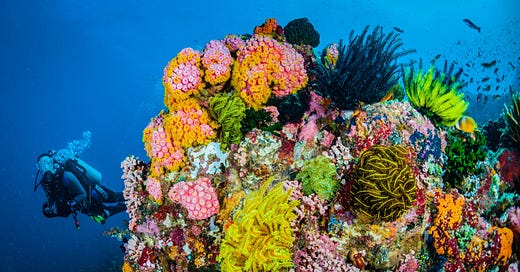After a particularly disappointing meeting about the virtues of toilet paper, advertising executive Richard Vevers quit his gig to become an ocean photographer. When he arrived in Australia, he saw a similar story as I had—our reefs were in trouble.
“That’s when I thought I should use my advertising skills to tackle issues,” he said by phone from his home. He never imagined he’d spearhead a project that might have the power to protect all life on this planet.
Photo courtesy of the 50 Reefs project
He created the Ocean Agency, partnered with Google to use street-view to identify and register reefs, and created an underwater military-grade camera. On the first day this project was open to the public, more people went virtual diving than have ever gone diving in all of human history.
For the first time in human history, people could see our reefs—the good, the bad, and the ugly—and suddenly, people were starting to believe the reality the scientists had been screaming about regarding our oceans.
However, now that they had access to all these reefs, there wasn’t enough funding to do a real scientific survey. So, Mr. Vevers reached in his toolkit of skills and branded the reefs as they might a sport star. “We needed to identify key issues that need addressing and find creative solutions to address those.”
Photo courtesy of the Ocean Agency
The tipping point
In 2014, a massive global bleaching event was occurring and Vevers’ team partnered with NOAA to become the underwater storm chasers getting images of bleaching in real time. They got the images on the front page of newspapers and suddenly coral reefs were sexy to care about. Director Jeff Orlowski (famous for his Chasing Ice documentary about glaciers) made Chasing Coral documenting The Ocean Agency’s work. Suddenly, their voices were amplified to a larger audience.
“People aren’t aware that the ocean is frontline of climate change,” Vevers explained. “We have to do more than reveal the issues and get people talking.” But, like many things, conservation was chronically underfunded. “We needed 7 times the amount that’s being spent on coral reef conservation. 93% of climate change is absorbed by ocean, enough to kill coral reefs. If we go over 1.5 degrees, we’ll kill 90%.”
He had to do more.
The idea that might save us all
Photo courtesy of the Coral Reef Image Bank
Vevers teamed up with thirteen of the planet’s top coral reef scientists and came up with perfect portfolio of 50 reefs to save. They assessed vulnerability to climate change, ability of reefs to reseed other reefs, ran data, found 50 reefs around world to conserve. They got funding, which led to more funding. But still, they needed more.
Once again, Vevers dug in his skillset and looked at how plastic pollution activists just had scientists and conservationists screaming about plastics in the sea for years until that viral turtle video came out. But once brands and celebrities got involved, the issue grew beyond activist issue and suddenly political capitol aligned with the cause.
“Government brands don’t want to align with activists, but when you get Adidas involved, when it’s cool to be involved in plastics and everyone wants in. Now there’s 2 million dollars for people working for solutions for plastics. Once innovations start, that’s a catalyst for more innovations. You have this cause that hasn’t had any support having so much money that people don’t know how to spend it.”
“Ad-execs sell things people don’t need,” Vevers said, “but we can use the skills for doing good. And getting the right people involved.”
Recovery
In Indonesia at one of the 50 reefs, recovery is happening quickly. In just three years, with the help of the scientists implementing techniques to heal the coral, Vevers says this reef is now one of the healthiest he’s ever seen. “Fish and 40 species of coral cover as far as eye can see.”
“We’re buying time for our reefs to survive. That’s where the hope comes in. We know we’ll lose a lot, but as long as we keep seed centers in the best places to repopulate and bounce back, we only need to save small amounts to get the reefs to bounce back. Our techniques can be use to allow reefs to repopulate very quickly. As long as we can save enough, nature bounces back quickly.”
Kids will change the world
“Gen Z is going to change the world,” Vevers added. “Millennials shook things up by insisting that brands were sustainable. They were prepared to switch brands if they weren’t sustainable. But for Gen Z, sustainability doesn’t cut it. It’s not just reducing damage and you have to do something good, they are insisting that they have brand purpose, and businesses are embracing that.”
He added that this is a huge business opportunity. “Once businesses get involved, others get involved. Conservation has changed in the last few years because of brands. This leads to government action. It’s an exciting time.”
A formula for change
Vevers’ formula to inspire change is as follows:
Create imagery to create outrage. A viral video of turtle gets everyone riled up.
Create optimism through showcasing innovation.
Show that it’s worth getting involved because there is hope.
Get celebrities, influencers, leaders to get involved. Make the issue cool and everyone wants to get involved, including governments.
“Passion sells it and persistence allows you to not give up on the first no,” Vevers explained.
This week’s action
This week, all you have to do is share this story of innovation with someone who might need a dash of hope, and also, if possible, with someone who has influence. See if we can start making attending to the Earth sexy.







